中国气象学会主办。
文章信息
- 谭桂容, 王一舒. 2016.
- TAN Guirong, WANG Yishu. 2016.
- 中高纬度与热带大气的共同作用对江南4-6月低频降水的影响
- Combined effects of mid-to high-latitudes and the tropic on the low-frequency precipitation in Jiangnan from April to June
- 气象学报, 74(3): 335-351
- Acta Meteorologica Sinica, 74(3): 335-351.
- http://dx.doi.org/10.11676/qxxb2016.032
-
文章历史
- 2016-01-26 收稿
- 2016-03-24 改回
中国降水存在显著的低频振荡(Low Frequency Oscillation,LFO)(齐艳君等,2008; 杨双艳等,2013,2014),且降水的低频振荡主周期随区域和季节而不同(王文等,2013; 黄丽娜等,2014)。如有的地区降水以10—20 d准双周振荡(Qusi-Biweekly Oscillation,QBWO)为主(王跃男等,2009; 信飞等,2007; 曹鑫等,2012),有的以30—60 d的季节内振荡(Intra-Seasonal Oscillation,ISO)为主(刘炜等,2014),还有的是以10—30 d的振荡占优势(庞玥等,2013; 曹鑫等,2013)。江南降水也存在显著的季节内变化特征,特别是在4—6月,江南地区降水较为集中(陈绍东等,2003; 梁萍等,2012b),有明显的10—30 d变化周期(谭桂容等,2016)。由于10—30 d振荡关乎当前延伸期低频降水预测(任宏利等,2006; 陈官军等,2012; 吕俊梅等,2012; 张玉洁等,2014; Zhu et al,2015),是亟待解决的技术难点和服务重点(金荣花等,2010; 梁萍等,2012a; 马浩等,2012),因此,对江南4—6月降水的10—30 d振荡成因进行分析具有重要的意义。
降水的低频变化与热带低频振荡及青藏高原的低频强迫等有关(孙照渤等,1991a,1991b; 李崇银等,1998; 刘式适等,2000; Hsu et al,2001; Long et al,2002),特别是热带低频强迫的作用。热带大气准双周振荡与低频降水有很显著的关系(李崇银等,1995; 贺佳佳等,2009; 曹鑫等,2012; 纪忠萍等,2012; 谷德军等,2013)。如贺佳佳等(2009)从准双周降水活跃事件和典型旱涝年准双周振荡的差异两方面对准双周振荡影响华南东部春季降水的分析显示,850 hPa 10—20 d低频风场的配置使10—20 d低频冷暖空气在华南交汇,有利于准双周降水处于活跃阶段。此外,热带季节内振荡也与低频降水和相关的大气环流联系紧密(朱乾根等,2000; Cassou,2008; Pan et al,2008; 梁萍等,2008; 贾燕等,2010; Wang et al,2013)。如梁萍等(2008)指出,江淮夏季典型涝年,热带西太平洋反气旋性低频环流的向北传播使得江淮地区形成暖性-冷性水汽输送的交汇,对江淮夏季降水偏多有重要作用。而针对中国东南部低频降水,大量研究基于Wheeler等(2004)定义的实时多变量马登-朱利安振荡指数(RMM)展开。如Zhang等(2009)、白旭旭等(2011)、章丽娜等(2011)根据实时多变量马登-朱利安振荡指数,采用合成分析方法对马登-朱利安振荡(MJO)不同位相对应的中国东南地区夏季降水异常、东部春季降水、华南前汛期降水及关联的热带环流特征进行了研究。结果表明,区域降水异常与马登-朱利安振荡位相的演变有密切的关系,主要与马登-朱利安振荡活跃中心位置的变化和西太平洋副热带高压等大尺度环流异常活动有关。马登-朱利安振荡主体在东传的过程中,可激发对流及其北传,引起水汽输送通道异常和降水异常。在对流活动从赤道印度洋西部到赤道西太平洋的东移过程中,中国东部冬季降水从长江流域到华南地区先后经历低频多雨过程(刘冬晴等,2010; 袁为等,2010)。
以往针对中国东南部低频降水成因的研究大多关注热带对流及相对应的大尺度背景场,关于中高纬度环流系统对低频降水直接影响的研究尚少。虽然有研究指出了中高纬度低频系统对区域持续性强降水的重要作用(陈官军,2014),但关于中高纬度环流系统与热带环流的相互作用及其对低频降水的影响还有待进一步研究。那么,江南低频降水是否与中高纬度环流密切相关?热带对流与中高纬度环流是否存在联系?又是如何联系?对中国江南地区低频降水又有怎样的影响呢?本研究旨在针对上述问题,对江南4—6月10—30 d低频降水展开讨论,并采用非滤波法(Hsu et al,2012,2015)提取10—30 d低频降水、低频背景场,着重分析热带对流与中高纬度大气环流的共同作用及其对江南低频降水的影响和可能机理,为江南4—6月延伸期低频降水的预测提供依据。文中提及的低频变量均指10—30 d时间尺度的低频变量。
2 资料和方法 2.1 资料使用的资料包括:(1)从中国气象科学数据共享服务网站()中获取的全中国2400多台站(包括国家气候观象台、国家气象观测一级站、二级站)逐日降水资料,选取江南地区(21.75°—32.25°N,109.75°—122.25°E)(万日金等,2008; 刘宣飞等,2013);(2)NCEP(National Centers for Environmental Prediction)/NCAR(National Center for Atmospheric Research)提供的全球逐日再分析资料,水平分辨率为2.5°×2.5°:包括200和850 hPa位势高度场、风场(垂直方向为17层)、湿度(垂直方向为12层)、海平面气压场;(3)NOAA(National Oceanic and Atmospheric Administration)提供的逐日向外长波辐射资料,水平分辨率为2.5°×2.5°。
资料的长度均为1979—2013年,降水资料取每年4月1日—6月30日,并去除年循环的降水距平序列。
2.2 方法
对低频降水、低频影响因子的提取采取了非滤波法(滑动平均): (t=10,11,12,…),为10 d以下成分分量;
(t=10,11,12,…),为10 d以下成分分量; (t=30,31,32,…),为30 d以下成分分量;
(t=30,31,32,…),为30 d以下成分分量;
 ,则为10—30 d低频分量。虽然,此滤波法会造成资料长度减少,但由于带通滤波法主要应用于历史资料的提取,在实时预测中,与实时预报相关的因子提取不方便使用带通滤波。文中采用滑动平均变换不仅便于实施,且能更好地应用于实时预报。
,则为10—30 d低频分量。虽然,此滤波法会造成资料长度减少,但由于带通滤波法主要应用于历史资料的提取,在实时预测中,与实时预报相关的因子提取不方便使用带通滤波。文中采用滑动平均变换不仅便于实施,且能更好地应用于实时预报。
为了讨论与江南4—6月低频降水相关联的大气环流特征,选取10—30 d低频降水方差贡献率最大的5年作为典型年,运用时滞相关分析寻求与低频降水相关显著的影响因子。文中使用的时滞相关为降水经验正交函数分解第1模态时间系数序列(记为PC1)的低频分量与低频影响因子的线性相关,相关分析自低频降水PC1滞后于低频影响因子30 d 至同期,间隔为5 d。为了得到热带-中高纬度的共同变化主模态,分别选取典型年热带向外长波辐射(OLR)和中高纬度200 hPa位势高度与低频降水的相关显著区(10°S—10°N,60°—120°E和60°—90°N,0°—120°E)进行奇异值分解(SVD),并将35年逐日向外长波辐射(XOLR)、200 hPa位势高度(XZ200)投影到典型年奇异值分解空间模态(VOLR、VZ200)上得到35年相应场的该模态逐日时间系数TOLR,TZ200(TOLR=VOLRTXOLR,TZ200=VZ200TXZ200)。
文中对位势高度、向外长波辐射、水汽通量等的相关、合成分析(Lau et al,1988; 毛江玉等,2005)采用t检验(李刚等,2012);而对于降水序列,因其概率分布往往不服从正态分布,在进行t检验之前需先将其变换成近似遵循正态分布的形式(Yeo et al,2000)

为了考察江南地区4—6月降水的空间分布特征,基于逐日未滤波降水距平场进行了经验正交函数分解(图 1)。经验正交函数分解前两个主要模态的方差贡献率分别为23.6%和18.4%。其中,第1模态表现为江南地区全区域一致的变化趋势,中心位于江南中部地区;第2模态成南北相反变化的空间分布。这两个主要模态均在一定程度上反映着江南地区降水变率的空间分布,文中主要对第1模态进行分析。
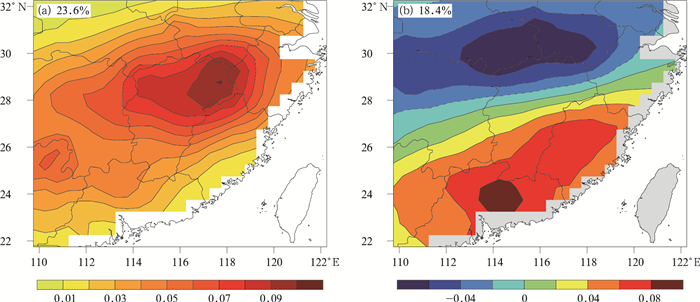 |
| 图 1 逐日未滤波降水经验正交函数分解第1(a)与第2(b)模态 Fig. 1 Spatial structures of the first (a) and second (b) EOF modes of unfiltered daily precipitation |
逐年计算10—30 d低频降水占原降水(未经滤波降水)的方差贡献率。其中,低频降水方差贡献率最大的5年分别为2011、1994、1998、1988和2008年。于是选取这5年作为低频降水典型年(5年低频成分的方差贡献在22.5%以上)进行进一步分析。
图 2为10—30 d低频降水占原降水方差贡献率的空间分布。可见无论是典型年降水还是35年的总降水,江南南部的低频降水方差贡献最大,典型年低频降水的方差贡献在此区域达到20%,比35年低频降水贡献约大5个百分点。
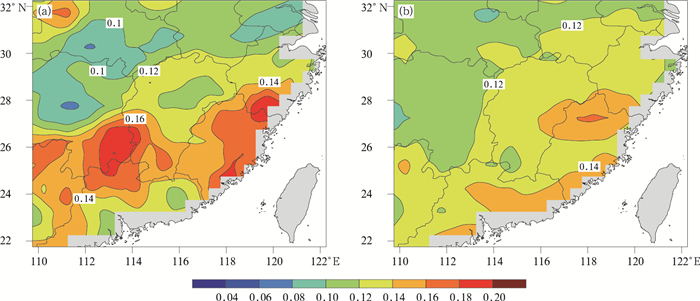 |
|
图 2 10—30 d低频降水方差占总降水方差之比的空间分布 (a.5个典型年低频降水方差贡献率; b.35年低频降水方差贡献率) Fig. 2 Spatial distributions of percentage ratio of variance accounted by the 10-30 d low-frequency daily precipitation to total precipitation variance (a. the variance contribution of the low-frequency precipitation in 5 typical years; b. the variance contribution of low-frequency precipitation in 35 years) |
为了寻求江南低频降水的影响因子,将典型年降水PC1的10—30 d分量分别与热带低频向外长波辐射和850 hPa纬向风进行时滞相关分析。无论是热带向外长波辐射(图 3a)还是850 hPa纬向风(图 3b)均与江南低频降水显著相关,部分区域相关系数超过0.4。当环流超前降水30—25 d时,热带印度洋向外长波辐射表现为与江南降水显著的正相关;超前降水20 d以内时,此对流抑制区逐渐减弱东移,印度洋及海洋性大陆一带为负相关区;同期,热带对流加强,旺盛区位于东印度洋及印度尼西亚海洋性大陆一带,江南降水偏多。与热带向外长波辐射相配合,自超前15 d起,850 hPa纬向风在向外长波辐射与低频降水显著的负相关区东侧为负相关大值区,即在对流旺盛区东侧对应850 hPa东风异常,这与以往研究中指出的马登-朱利安振荡对流主体东侧有低层东风异常相对应是一致的(李崇银等,2013,2014; Li,2014)。从超前30 d至同期的向外长波辐射及850 hPa纬向风变化趋势均可以看出马登-朱利安振荡系统的东移,当马登-朱利安振荡对流主体位于赤道东印度洋及印度尼西亚一带时,江南4—6月低频降水异常偏多。
 |
|
图 3 低频降水PC1与低频向外长波辐射(a)及低频850 hPa纬向风(b)相关系数分布 (低频降水落后30 d至同期,间隔5 d;相关系数等值线间隔0.1; 阴影区表示相关系数通过95%信度检验) Fig. 3 Correlation coefficients between PC1 of low-frequency precipitation and OLR (a), U850 (b) (the precipitation lags OLR and 850 hPa winds by 30 to 0 days with an interval of 5-day; the contour interval is 0.1; shaded areas are for correlation coefficients exceeding the 95 % confidence level) |
为了考察中高纬度大气环流与低频降水的关系,将典型年低频降水PC1与低频位势高度进行同期及位势高度超前的时滞相关分析(图 4)。当位势高度超前降水30—25 d时,欧洲至西西伯利亚与低频降水成显著的负相关,北美高纬度地区为正相关。之后异常强度逐渐减弱,并演变为与超前30 d时相反的相关关系。同期,江南上空低频降水与低层位势高度成负相关,高层正相关,高层辐散低层辐合,有利于降水偏多。江南低频降水偏多时,高纬度欧洲至西西伯利亚存在显著的正高度异常,江南上游至贝加尔湖位势高度为显著负异常,表明高纬度阻塞型环流异常,有利于冷空气南下与暖湿气流交汇于江南而形成该地区降水正异常。
 |
|
图 4 低频降水PC1与低频850 hPa(a)及200 hPa(b)位势高度相关系数分布 (位势高度超前降水30—0 d,间隔5 d;相关系数等值线间隔0.1; 阴影区表示相关系数通过95%信度检验) Fig. 4 Correlation coefficients between PC1 of the low-frequency precipitation and 850 hPa (a), 200 hPa (b) geopotential height (The geopotential height lags precipitation by -30 to 0 days with a interval of 5-day; the contour interval is 0.1; shaded areas indicate where correlation coefficients exceed the 95 % confidence level) |
由以上分析可见,江南4—6月低频降水不仅与热带对流关系密切,且与中高纬度环流也有很好的相关。参照图 3a和图 4中的相关显著区,针对低频降水典型年,分别选取向外长波辐射(10°S—10°N,60°—120°E)和200 hPa位势高度(60°—90°N,0°—120°E)进行奇异值分解,得到中高纬度大气环流与热带对流的耦合主模态。奇异值分解前2个模态的方差贡献率分别为60.11%和21.99%,左右场时间系数的相关分别为0.429和0.527,均通过了99%的显著性检验,这里主要讨论第1模态。图 5为奇异值分解第1模态异类相关分布,可见左场上,欧洲至西伯利亚及北美的高纬度地区存在显著的相关区;而右场上,主要的高相关区在东印度洋、印度尼西亚一带,相关系数超过0.4。表明当东印度洋及印度尼西亚一带对流受抑制时,欧洲至西伯利亚高纬度地区呈显著的负高度异常。
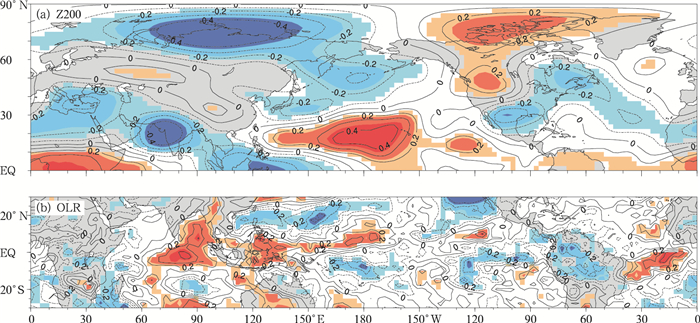 |
|
图 5 奇异值分解第1模态左、右场异类相关的相关系数分布 (a.左场:Z200,b.右场:OLR;相关系数等值线间隔0.1,阴影区表示相关系数通过95%信度检验) Fig. 5 The heterogeneous correlation distributions from the SVD analysis (a. The heterogeneous correlation distribution of the left vector: Z200; b. the heterogeneous correlation distribution of the right vector: OLR; the contour interval is 0.1; shaded areas are for correlation coefficients exceeding the 95 % confidence level) |
为了讨论中高纬度大气环流与热带对流共同影响江南4—6月低频降水的可能机理,分别将1979—2013年4—6月的低频环流场XOLR、XZ200投影到典型年奇异值分解空间主模态上,得到35年的逐日时间系数序列TOLR=VOLRTXOLR,TZ200=VZ200TXZ200。若以TZ200为x轴,TOLR为y轴,则构成的4个象限代表了中高纬度大气环流和热带对流的4种不同配置型(图 6),即热带东印度洋、印度尼西亚一带向外长波辐射正异常,中高纬度欧洲至西西伯利亚地区200 hPa位势高度(Z200)负异常(第1象限,简称PN型);热带向外长波辐射正异常,中高纬度200 hPa位势高度正异常(第2象限,简称PP型);热带向外长波辐射负异常,中高纬度200 hPa位势高度正异常(第3象限,简称NP型);热带向外长波辐射负异常,中高纬度200 hPa位势高度负异常(第4象限,简称NN型)。据统计,35年中4种配置型发生机率相近。其中,PN型反映中高纬度大气环流与热带对流对江南低频降水的同负贡献;NP型则为同正贡献。
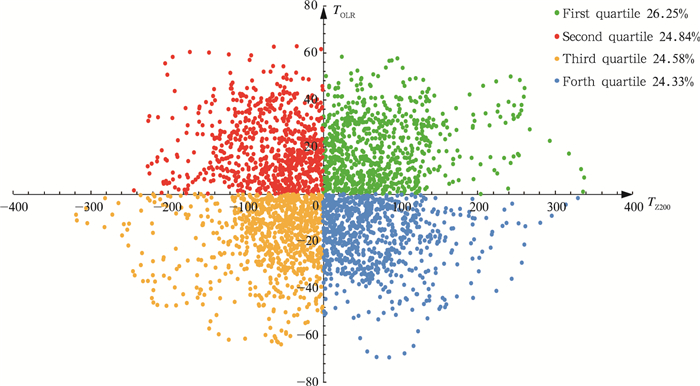 |
| 图 6 逐日降水个例的热带-中高纬度异常配置型划分散点分布 Fig. 6 Scatter diagram of the criterion for dividing the configuration of the daily cases |
筛选NP型和PN型个例进行降水距平的合成分析(图 7),样本量分别为783和836。可见NP型在超前30—20 d时整个江南地区降水异常偏少,超前15 d时开始发生变化,降水呈南北相反的空间分布型,超前10 d至同期,江南低频降水表现为正异常,对应江南低频降水“湿型”;PN型降水异常特征则与NP型基本相反,对应“干型”。两者都在环流超前降水5 d时达到降水异常的峰值。因此,当东印度洋、印度尼西亚一带热带对流偏弱,欧洲至西西伯利亚高纬度地区高层位势高度负异常,即热带-中高纬度呈PN型配置时,对应江南4—6月降水偏少;当东印度洋、印度尼西亚一带热带对流旺盛,欧洲至西西伯利亚高纬度地区高层位势高度正异常,即NP型配置时,江南4—6月低频降水偏多。
 |
|
图 7 降水距平合成分析 (a.“湿型”,b.“干型”;环流超前降水30 d至同期,间隔5 d;打点区通过95%信度检验) Fig. 7 Composites of rainfall anomalies (a. wet pattern, b. dry pattern; the circulation lags precipitation by -30 to 0 days, with an interval of 5-day; the dotted denote the correlation coefficients exceeding the 95% confidence level) |
进一步对200 hPa位势高度、200和850 hPa势函数、整层水汽通量及散度进行合成分析。从“湿型”合成图中可见,超前30 d至同期,势函数(图 8a)反映的热带对流呈东移的趋势。同期,热带印度洋及印度尼西亚一带势函数高层辐散低层辐合(低层图略),对流旺盛,对流释放凝结潜热可引起强烈的上升运动并激发罗斯贝波响应。在200 hPa位势高度异常(图 9a)中可以看出明显的罗斯贝波列,江南在波列影响区范围内:位势高度超前30—25 d时,江南地区表现为深厚的正高度异常;超前20—10 d时,经向波列明显;传播到超前5 d至同期后,江南及上游贝加尔湖附近表现为高低层一致的负高度异常(低层图略)。由图 10a可以看出,前期江南及上游整层水汽反气旋式辐散,不利于降水的发生;在约超前5 d 时,江南整层水汽输送开始增强,孟加拉湾地区显著增强的水汽辐合经由江南上游低压气旋底前部的西南风将旺盛的水汽输送至江南,江南地区整层水汽辐合,有利于降水正异常的发生。
 |
|
图 8 200 hPa速度势异常合成分析 (a. “湿型”,b. “干型”;速度势异常超前降水30 d至同期,间隔5 d;打点区通过95%信度检验) Fig. 8 Composites of 200 hPa velocity potential anomalies (a. wet pattern, b. dry pattern; the velocity potential anomalies lag precipitation by -30 to 0 days, with a 5-day interval; the dotted denote the correlation coefficients exceeding the 95% confidence level) |
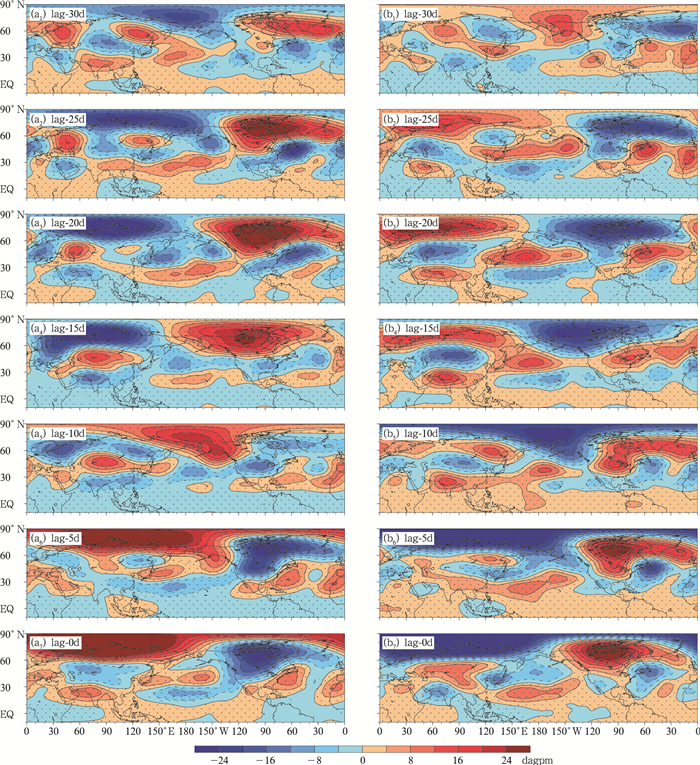 |
|
图 9 200 hPa位势高度异常合成分析 (a. “湿型”,b. “干型”;位势高度异常超前降水30 d至同期,间隔5 d;打点区通过95%信度检验) Fig. 9 Composites of 200 hPa geopotential height anomalies (a. wet pattern, b. dry pattern; the geopotential height anomalies lag precipitation by -30 to 0 days, with an interval of 5 day; the dotted denote the correlation coefficients exceeding the 95% confidence level) |
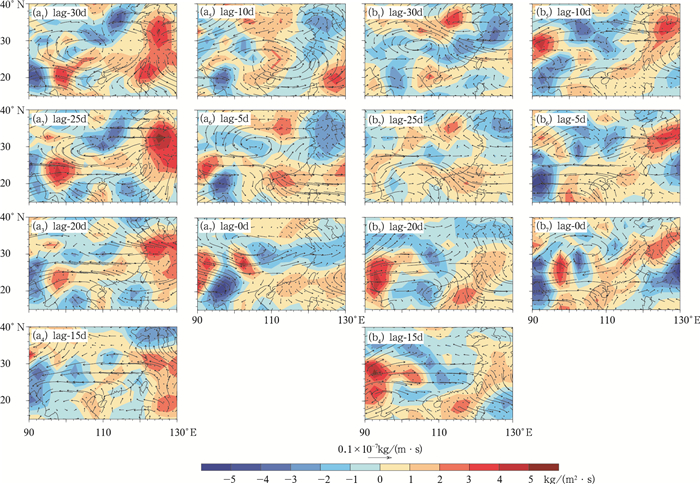 |
| 图 10 整层水汽通量及散度异常合成分析(a. “湿型”,b. “干型”;水汽通量及散度异常超前降水 30 d至同期,间隔5 d;打点区通过95%信度检验,填色等值线为水汽通量散度, 矢量箭头为水汽通量) Fig. 10 Composites of moisture flux over the entire layer and divergence anomalies(a. wet pattern, b. dry pattern; the moisture flux and divergence anomalies lag precipitation by -30 to 0 days, with an interval of 5 day; the dotted denote the correlation coefficients exceeding the 95% confidence level; color shaded areas indicate areas of vapor flux divergence, vector arrows show the vapor flux) |
类似地,对于“干型”,势函数(图 8b)反映的热带对流同样呈东移的趋势,但同期热带印度洋及印度尼西亚一带表现为速度势的高层辐合低层辐散,对流被抑制;200 hPa位势高度异常(图 9b)也呈现与“湿型”相反的波型,江南上游波列在约超前20—10 d时最明显,超前5 d至同期表现为江南及上游地区的正高度异常。反气旋底前部的东北风不利于水汽输送,且江南、孟加拉湾地区整层水汽辐散(图 10b),不利于降水正异常的发生。
为进一步分析影响江南低频降水的中高纬度环流及热带对流的传播特征,下文给出了“湿、干型” 200 hPa位势高度和向外长波辐射的传播特征(图 11—14)。
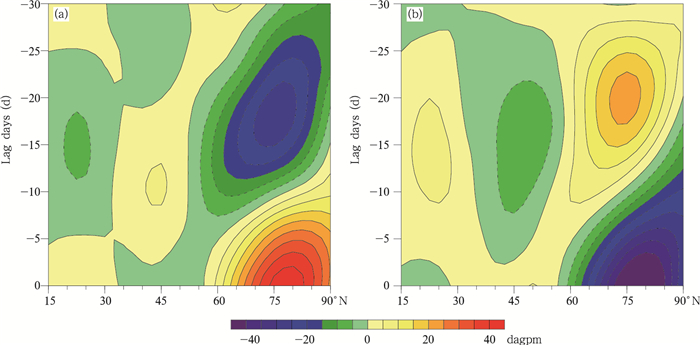 |
| 图 11 200 hPa位势高度异常(0—120°E纬向平均)经向传播(a. “湿型”,b. “干型”) Fig. 11 Meridional propagations of 200 hPa geopotential height anomaly (0-120°E zonal mean) (a. wet pattern, b. dry pattern) |
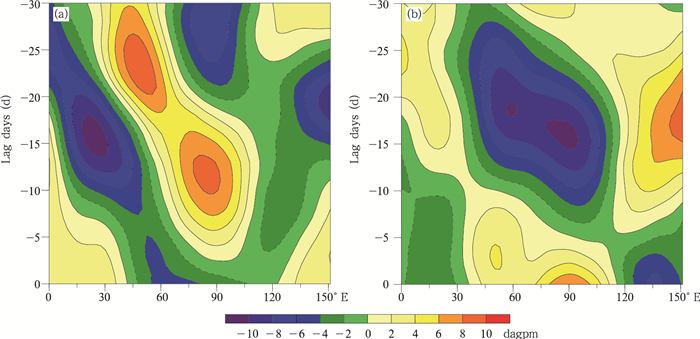 |
| 图 12 200 hPa位势高度异常(30°—60°N经向平均)纬向传播(a. “湿型”,b. “干型”) Fig. 12 Zonal propagations of 200 hPa geopotential height anomaly (30°-60°N meridional mean) (a. wet pattern, b. dry pattern) |
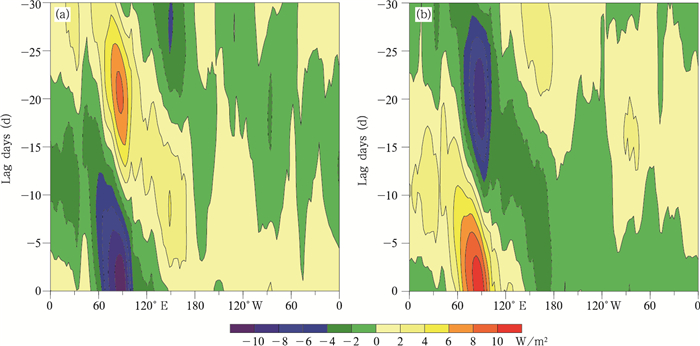 |
| 图 13 热带OLR异常(15°S—15°N经向平均)纬向传播(a. “湿型”,b. “干型”) Fig. 13 Zonal propagations of tropical OLR anomaly (15°S—15°N meridional mean) (a. wet pattern, b. dry pattern) |
 |
| 图 14 200 hPa位势高度异常(60°—120°E纬向平均)经向传播 (a,“湿型”,b. “干型”) Fig. 14 Meridional propagations of 200 hPa geopotential height anomaly (60°-120°E zonal mean) (a. wet pattern, b. dry pattern) |
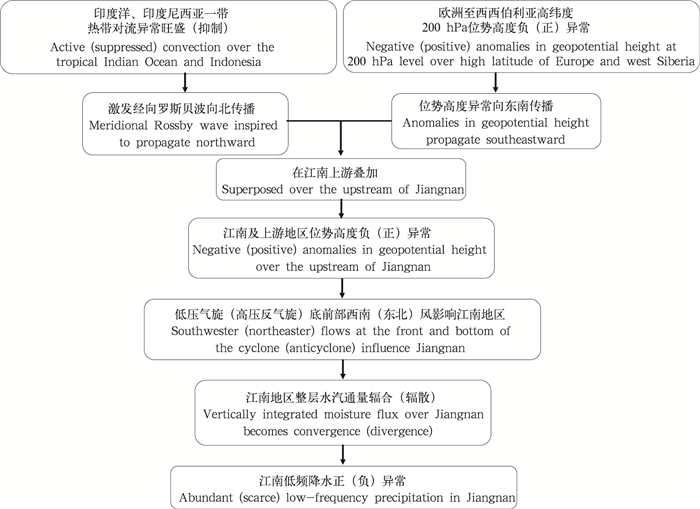 |
| 图 15 热带对流与中高纬度大气环流共同作用概念 Fig. 15 Schematic diagram of the combined effects of tropical convection and atmospheric circulation over the mid- to high-latitudes |
分别选取30°—60°N,0°—120°E 区域对200 hPa位势高度异常作纬向平均和径向平均。从经向-时间(图 11)和纬向-时间(图 12)剖面图可见,“湿型”欧洲至西伯利亚高纬度地区200 hPa位势高度负异常自超前30 d开始呈现明显的向东南方向传播的趋势,同期负异常传播至江南上游(30°—60°N,60°—120°E);“干型”的传播特征与“湿型”类似,只是传播的异常分布型相反。而对于热带对流,选取15°S—15°N作向外长波辐射异常的经向平均(图 13),可见热带对流存在显著东传特征,在约超前15 d时,对流旺盛区(抑制区)传播至东印度洋、印度尼西亚一带。若选取60°—120°E对200 hPa位势高度异常进行纬向平均(图 14),可清楚地看到自超前15 d开始,位于东印度洋的热带热源激发的罗斯贝波向北传播,至同期异常也传播至30°—60°N,与高纬度南传的异常在江南上游相叠加。
以上分析可见,“湿型”东印度洋、印度尼西亚一带热带对流旺盛区的非绝热加热作用引起显著的上升运动,并激发经向罗斯贝波向北传播;同时高纬度欧洲至西伯利亚地区位势高度负异常向东向南传播,两者在江南上游(30°—60°N; 60°—120°E)上空叠加加强,异常低压底前部的西南风将孟加拉湾充沛的水汽输送至江南地区,有利于江南低频降水偏多;反之亦然(图 15)。
5 结果与讨论采用非滤波法,提取了江南4—6月10—30 d低频降水,重点分析了热带与中高纬度共同作用对江南低频降水的影响,主要结论如下:
(1)江南地区4—6月降水主要呈现全区变化趋势一致和南北变化相反的两种空间分布型。10—30 d低频降水方差贡献率最大的5个典型年为2011、1994、1998、1988和2008年。低频降水方差贡献率较大的区域位于江南南部,典型年的低频降水方差贡献率可达20%。
(2)江南低频降水不仅与东传的热带对流有关,还与中高纬度大气环流显著相关,两者共同作用于江南低频降水。当印度洋及印度尼西亚一带对流旺盛,中国上游欧洲至西伯利亚地区高纬度位势高度场正异常,北美高纬度、贝加尔湖及其以南地区负异常时,江南4—6月为低频降水“湿型”;反之为“干型”。
(3)中高纬度与热带共同作用的可能机理为:当热带对流旺盛区位于东印度洋及印度尼西亚海洋性大陆一带时,热带热源的非绝热加热引起显著的上升运动并激发经向传播的罗斯贝波向北传播;同时高纬度欧洲至西伯利亚地区位势高度负异常向东向南传播,两者在江南上游叠加加强,低压底前部的西南风将孟加拉湾旺盛的水汽输送至江南,江南地区整层水汽通量辐合,低频降水偏多;反之亦然。
值得注意的是,文中只着重分析了热带对流及中高纬度大气环流对江南低频降水的同正、同负贡献,关于中高纬度大气环流异常的原因还未分析;此外,当热带与中高纬度对降水的贡献相反时,究竟哪方面因子的影响占主导呢?这将在以后的研究中进行分析。
| 白旭旭, 李崇银, 谭言科等. 2011. MJO对我国东部春季降水影响的分析. 热带气象学报, 27(6):814-822. Bai X X, Li C Y, Tan T K, et al. 2011. Impacts of the MJO (Madden-Julian Oscillation) on spring rainfall in East China. J Trop Meteor, 27(6):814-822(in Chinese) |
| 曹鑫, 任雪娟, 杨修群等. 2012. 中国东南部5-8月持续性强降水和环流异常的准双周振荡. 气象学报, 70(4):766-778. Cao X, Ren X J, Yang X Q, et al. 2012. The quasi-biweekly oscillation characteristics of persistent heavy rain and associated general circulation anomaly over Southeast China from May to August. Acta Meteor Sinica, 70(4):766-778(in Chinese) |
| 曹鑫, 任雪娟, 孙旭光. 2013. 江淮流域夏季持续性强降水的低频特征分析. 气象科学, 33(4):362-370. Cao X, Ren X J, Sun X G. 2013. Low-frequency oscillations of persistent heavy rainfall over Yangtze-Huaihe River Basin. Scientia Meteor Sinica, 33(4):362-370(in Chinese) |
| 陈官军, 魏凤英. 2012. 基于低频振荡特征的夏季江淮持续性降水延伸期预报方法. 大气科学, 36(3):633-644. Chen G J, Wei F Y. 2012. An extended-range forecast method for the persistent heavy rainfall over the Yangtze-Huaihe River valley in the summer based on the low-frequency oscillation characteristics. Chinese J Atmos Sci, 36(3):633-644(in Chinese) |
| 陈官军. 2014. 中国南方夏季区域持续性强降水与大气季节内振荡[D]. 北京:中国气象科学研究院. Chen G J. 2014. Intraseasonal oscillation of the summer monsoon and its influence on regionally persistent heavy rainfall over southern China[D]. Beijing:Chinese Academy of Meteorological Sciences (in Chinese) |
| 陈绍东, 王谦谦, 钱永甫. 2003. 江南汛期降水基本气候特征及其与海温异常关系初探. 热带气象学报, 19(3):260-268. Chen S D, Wang Q Q, Qian Y P. 2003. Preliminary discussions of basic climatic characteristics of precipitation during rainy seasons in lower Yangzi River Valley and its relationship with SST anomalies. J Trop Meteor, 19(3):260-268(in Chinese) |
| 谷德军,纪忠萍,高晓荣等. 2013. 广东前汛期降水与南海北部风场准双周振荡的关系. 热带气象学报, 29(2):189-197. Gu D J, Ji Z P, Gao X R, et al. 2013. The relationship between the rainfall during the pre-flood rainy season in Guangdong and the quasi-biweekly oscillation of wind field in northern South China Sea. J Trop Meteor, 29(2):189-197(in Chinese) |
| 贺佳佳, 温之平. 2009. 准双周振荡对华南春季降水的影响. 第26届中国气象学会年会季风动力学论坛分会场论文集. He J J, Wen Z P. 2009. Impacts of the quasi-biweekly oscillation on spring rainfall in South China. 26st Conf. On Monsoon Dynamics. |
| 黄丽娜, 高建芸, 陈彩珠等. 2014. 福建前汛期持续性强降水的大气低频特征分析. 气象, 40(6):723-732. Huang L N, Gao J Y, Chen C Z, et al. 2014. Analysis on atmospheric low-frequency features associated with persistent heavy rains during the pre-flood season in Fujian. Meteor Mon, 40(6):723-732(in Chinese) |
| 纪忠萍,吴秀兰,刘燕等. 2012. 西江流域汛期暴雨与500 hPa关键区准双周振荡的关系. 热带气象学报, 28(4):497-505. Ji Z P, Wu X L, Liu Y, et al. 2012.Variations of torrential rain during the flood season in Xijiang river region and their relationships with the quasi-biweekly oscillation of 500 hPa key region. J Trop Meteor, 28(4):497-505(in Chinese) |
| 贾燕, 管兆勇. 2010. 江淮流域夏季降水异常与西北太平洋副热带30-60天振荡强度年际变化的联系. 大气科学, 34(4):691-702. Jia Y, Guan Z Y. 2010. Associations of summertime rainfall anomalies over the Changjiang-Huaihe River valley with the interannual variability of the 30-60 day oscillation intensity in the northwestern Pacific. Chinese J Atmos Sci, 34(4):691-702(in Chinese) |
| 金荣花, 马杰, 毕宝贵. 2010.10-30 d延伸期预报研究进展和业务现状. 沙漠与绿洲气象, 4(2):1-5. Jin R H, Ma J, Bi B G. 2010. Research progress and operation status about the extended range forecast from 10 to 30 days. Desert Oasis Meteor, 4(2):1-5(in Chinese) |
| 李崇银, 周亚萍. 1995. 热带大气中的准双周(10-20天)振荡. 大气科学, 19(4):435-444. Li C Y, Zhou Y P. 1995. On quais-two-week (10-20 day) oscillation in the tropical atmosphere. Chinese J Atmos Sci, 19(4):435-444(in Chinese) |
| 李崇银, 廖清海. 1998. 热带大气季节内振荡激发El Nino的机制. 热带气象学报, 14(2):2-10. Li C Y, Liao Q H. 1998. The triggering mechanism for the tropical intraseasonal oscillation for El Nino event. J Trop Meteor, 14(2):2-10(in Chinese) |
| 李崇银, 潘静, 宋洁. 2013. MJO研究新进展. 大气科学, 37(2):229-252. Li C Y, Pan J, Song J. 2013. The progress on the MJO research in recent years. Chinese J Atmos Sci, 37(2):229-252(in Chinese) |
| 李崇银, 凌健, 宋洁等. 2014. 中国热带大气季节内振荡研究进展. 气象学报, 72(5):817-834. Li C Y, Ling J, Song J, et al. 2014. Research progress in China on the tropical atmospheric intraseasonal oscillation. Acta Meteor Sinica, 72(5):817-834(in Chinese) |
| 李刚, 李崇银, 谭言科等. 2012. 北半球冬季南太平洋海表温度异常的主要模态及其与ENSO的关系. 海洋学报, 34(2):48-56. Li G, Li C Y, Tan Y K, et al. 2012. Principal models of the boreal winter SSTA in the South Pacific and their relationships with the ENSO. Acta Oceanologica Sinica, 34(2):48-56(in Chinese) |
| 梁萍, 陈隆勋, 何金海. 2008. 江淮夏季典型旱涝年的水汽输送低频振荡特征. 高原气象, 27(S1):84-91. Liang P, Chen L X, He J H. 2008. Features of low frequency oscillation for moisture transport during typical drought/flood years over the Yangtze-Huaihe basin. Plateau Meteor, 27(S1):84-91(in Chinese) |
| 梁萍, 丁一汇. 2012a. 基于季节内振荡的延伸预报试验. 大气科学, 36(1):102-116. Liang P, Ding Y H. 2012a. An extended range forecast experiment based on the intraseasonal oscillation. Chinese J Atmos Sci 36(1):102-116(in Chinese), |
| 梁萍, 丁一汇. 2012b. 东亚梅雨季节内振荡的气候特征. 气象学报, 70(3):418-435. Liang P, Ding Y H. 2012b. Climatic features of intraseasonal oscillation of East Asia Meiyu. Acta Meteor Sinica, 70(3):418-435(in Chinese) |
| 刘冬晴, 杨修群. 2010. 热带低频振荡影响中国东部冬季降水的机理. 气象科学, 30(5):684-693. Liu D Q, Yang X Q. 2010. The mechanism for the impact of Madden-Julian oscillation on wintertime rainfall over eastern China. Scientia Meteor Sinica, 30(5):684-693(in Chinese) |
| 刘式适, 柏晶瑜, 徐祥德等. 2000. 青藏高原大地形的动力、热力作用与低频振荡. 应用气象学报, 11(3):312-321. Liu S S, Bai J Y, Xu X D, et al. 2000. Dynamic and thermodynamic effects of the Tibetan plateau and the low-frequency oscillation. J Appl Meteor Sci, 11(3):312-321(in Chinese) |
| 刘炜, 周顺武, 智海. 2014.1998年夏季青藏髙原东南部降水低频振荡特征. 气象, 40(5):530-540. Liu W, Zhou S W, Zhi H. 2014. Characteristics of 30-60 d oscillation of precipitation over the Southeast Tibetan Plateau in the summer of 1998. Meteor Mon, 40(5):530-540(in Chinese) |
| 刘宣飞, 袁旭. 2013. 江南春雨的两个阶段及其降水性质. 热带气象学报, 29(1):99-105. Liu X F, Yuan X. 2013. Two stages of spring persistent rains over Southeast China and the nature of the precipitation. J Trop Meteor, 29(1):99-105(in Chinese) |
| 吕俊梅, 琚建华, 任菊章等. 2012. 热带大气MJO活动异常对2009-2010年云南极端干旱的影响. 中国科学(D辑):地球科学, 42(4):599-613. Lü J M, Ju J H, Ren J Z, et al. 2012. The influence of the Madden-Julian oscillation activity anomalies on Yunnan's extreme drought of 2009-2010. Sci China:Earth Sci, 42(4):599-613(in Chinese) |
| 马浩, 毛燕军, 雷媛等. 2012.10-30 d延伸期天气预报研究进展综述. 干旱气象, 30(4):514-521+554. Ma H, Mao Y J, Lei Y, et al. 2012. Advances in the study of 10-30 days extended-range weather forecast. Arid Meteor, 30(4):514-521+554(in Chinese) |
| 毛江玉, 吴国雄. 2005.1991年江淮梅雨与副热带高压的低频振荡. 气象学报, 63(5):762-770. Mao J Y, Wu G X. 2005. Intraseasonal variability in the Yangtze-Huaihe river rainfall and the subtropical high during the 1991 Meiyu period. Acta Meteor Sinica, 63(5):762-770(in Chinese) |
| 庞玥, 王黎娟, 于波. 2013. 江淮流域梅雨期降水与10-30 d低频振荡的联系. 大气科学学报, 36(6):742-750.Pang Y, Wang L J, Yu B. 2013. The relationship between 10-30 d low-frequency oscillation and the rainfall over Changjiang-Huaihe River Valley during Meiyu period. Trans Atmos Sci, 36(6):742-750(in Chinese) |
| 齐艳军, 张人禾, 李天明等. 2008. 大气季节内振荡在印度夏季风建立和年际变化中的作用. 科学通报, 53(23):2972-2975. Qi Y J, Zhang R H, Tim L, et al. 2008. Effects of intraseasonal oscillation on the onset of the Indian summer monsoon and its interannual variability. Chin Sci Bull, 53(23):2972-2975(in Chinese) |
| 任宏利, 张培群, 李维京等. 2006. 西北区东部春季降水及其水汽输送的低频振荡特征. 高原气象, 25(2):285-292. Ren H L, Zhang P Q, Li W J, et al. 2006. Low-frequency oscillation characteristics of precipitation and water vapor transport in the eastern part of Northwest China in the spring. Plateau Meteor, 25(2):285-292(in Chinese) |
| 孙照渤, 章基嘉, 陈葆德等. 1991a. 北半球理想地形对冬季大气低频变化动力作用的数值试验. 南京气象学院学报, 14(S1):376-382. Sun Z B, Zhang J J, Chen B D, et al. 1991a. Numerical experiments of the dynamic effects of the northern idealized terrain on the low-frequency variation of the winter atmosphere. J Nanjing Inst Meteor, 14(S1):376-382(in Chinese) |
| 孙照渤, 李云康, 章基嘉. 1991b. 夏半年青藏高原及附近地区30-60天振荡的分布特征. 南京气象学院学报, 14(4):497-502. Sun Z B, Li Y K, Zhang J J. 1991b. Detection of the 30-60 day oscillation over the Qinghai-Xizang Plateau and its surrounding areas during summertime. J Nanjing Inst Meteor, 14(4):497-502(in Chinese) |
| 谭桂容, 高萌, 张文君等. 2016. 中国东南部地区4-6月强降水的低频变化特征. 气象科学,http://www.cnki.net/kcms/detail/32.1243.P.20160118.1636.022.html. Tan G R, Gao M, Zhang W J, et al. 2016. Low frequency variation characteristics of strong rainfall over Southeast China from April to June. Scientia Meteor Sinica,http://www.cnki.net/kcms/detail/32.1243.P.20160118.1636.022.html (in Chinese) |
| 万日金, 王同美, 吴国雄. 2008. 江南春雨和南海副热带高压的时间演变及其与东亚夏季风环流和降水的关系. 气象学报, 66(5):800-807. Wan R J, Wang T M, Wu G X. 2008. Temporal variations of the springtime persistent rainfall and SCS subtropical high and their correlations to the circulation and precipitation of the East Asia summer monsoon. Acta Meteor Sinica, 66(5):800-807(in Chinese) |
| 王文, 李伟, 李耀辉. 2013. 黄河中下游地区夏季旱涝年低频振荡特征分析. 冰川冻土, 35(4):1007-1014. Wang W, Li W, Li Y Y. 2013. Analysis of the LFO characteristics in summer drought/flood years over the middle and lower reaches of the Yellow River. J Glaciology and Geocryology, 35(4):1007-1014(in Chinese) |
| 王跃男, 陈隆勋, 何金海等. 2009. 夏季青藏高原热源低频振荡对我国东部降水的影响. 应用气象学报, 20(4):419-427. Wang Y N, Chen L X, He J H, et al. 2009. Effects of low-frequency oscillation of the summer heat source over the Tibetan Plateau on precipitation in eastern China. J Appl Meteor Sci, 20(4):419-427(in Chinese) |
| 信飞, 肖子牛, 李泽椿. 2007.1997年华南汛期降水异常与大气低频振荡的关系. 气象, 33(12):23-30. Xin F, Xiao Z N, Li Z C. 2007. The relationship between flood season precipitation anomalies in South China and East Asian atmospheric low frequency oscillation in 1997. Meteor Mon, 33(12):23-30(in Chinese) |
| 杨双艳, 武炳义, 张人禾等. 2013. 夏季欧亚中高纬大气低频振荡的纬向传播特征. 中国科学D:地球科学, 43(7):1220-1230. Yang S Y, Wu B Y, Zhang R H, et al. 2013. The zonal propagating characteristics of low-frequency oscillation over the Eurasian mid-and high-latitudes in the boreal summer. Sci China:Earth Sci, 43(7):1220-1230(in Chinese) |
| 杨双艳, 武炳义, 张人禾等. 2014. 冬季欧亚中高纬大气低频振荡的传播及其与欧亚遥相关型的关系. 大气科学, 38(1):121-132. Yang S Y, Wu B Y, Zhang R H, et al. 2014. Propagation of low-frequency oscillation over Eurasian mid-and high-latitudes in the winter and its association with the Eurasian teleconnection pattern. Chinese J Atmos Sci, 38(1):121-132(in Chinese) |
| 袁为, 杨海军. 2010. Madden-Julian振荡对中国东南部冬季降水的调制. 北京大学学报(自然科学版), 46(2):207-214. Yuan W, Yang H J. 2010. On the modulation of MJO to the precipitation in Southeast China in the winter. Acta Scientiarum Naturalium Universitatis Pekinensis, 46(2):207-214(in Chinese) |
| 章丽娜, 林鹏飞, 熊喆等. 2011. 热带大气季节内振荡对华南前汛期降水的影响. 大气科学, 35(3):560-570. Zhang L N, Lin P F, Xiong Z, et al. 2011. Impacts of the Madden-Julian Oscillation on pre-flood season precipitation in South China. Chinese J Atmos Sci, 35(3):560-570(in Chinese) |
| 张玉洁,刘寿东,任宏利等. 2014. 中国南方夏季低频雨型特征及其年代际变化研究. 气象学报, 72(6):1205-1217. Zhang Y J, Liu S D, Ren H L, et al. 2014. Characteristics and inter-decadal variations of the low-frequency rainfall regimes over southern China in the summer. Acta Meteor Sinica, 72(6):1205-1217(in Chinese) |
| 朱乾根, 徐国强. 2000.1998年夏季中国南部低频降水特征与南海低频夏季风活动. 气象科学, 20(3):239-248. Zhu Q G, Xu G Q. 2000. Features of LFP in South China and SCSLF summer monsoon activity in the summer of 1998. Scientia Meteor Sinica, 20(3):239-248(in Chinese) |
| Cassou C. 2008. Intraseasonal interaction between the Madden-Julian Oscillation and the North Atlantic Oscillation. Nature, 455:523-527 |
| Hsu H H, Weng C H. 2001. Northwestward propagation of the intraseasonal oscillation in the Western North Pacific during the boreal summer:Structure and mechanism. J Climate, 14:3834-3850 |
| Hsu P C, Li T, Lin Y C, et al. 2012. A spatial-temporal projection method for seasonal prediction of spring rainfall in northern Taiwan. J Meteor Soc Japan, 90:179-190 |
| Hsu P C, Li T, You L, et al. 2015. A spatial-temporal projection method for 10-30-day forecast of heavy rainfall in Southern China. Climate Dyn, 44:1227-1244 |
| Lau K M, Yang G J, Shen S H. 1988. Seasonal and intraseasonal climatology of summer monsoon rainfall over East Asia. Mon Wea Rev, 116:18-37 |
| Li T. 2014. Recent advance in understanding the dynamics of the Madden-Julian oscillation. J Meteor Res, 28:1-33 |
| Long Z X, Li C Y. 2002. Interannual variation of tropical atmospheric 30-60 day low-frequency oscillation and ENSO cycle. Chinese J Atmos Sci, 26:51-62 |
| Pan L L, Li T. 2008. Interactions between the tropical ISO and midlatitude low-frequency flow. Climate Dyn, 31:375-388 |
| Wang L, Li T, Zhou T, et al. 2013. Origin of the intraseasonal variability over the North Pacific in boreal summer. J Climate, 26:1211-1229 |
| Wheeler M C, Hendon H H. 2004. An all-season real-time multivariate MJO index:Development of an index for monitoring and prediction. Mon Wea Rev, 132:1917-1932 |
| Yeo I K, Johnson R A. 2000. A new family of power transformation to improve normality or symmetry. Biometrika, 87(4):954-959 |
| Zhang L, Wang B, Zeng Q. 2009. Impact of the Madden-Julian oscillation on summer rainfall in Southeast China. J Climate, 22:201-216 |
| Zhu Z W, Li T, Hsu P C, et al. 2015. A spatial-temporal projection model for extended range forecast in the tropics. Climate Dyn, 45:1085-1098 |
 2016, Vol. 74
2016, Vol. 74

